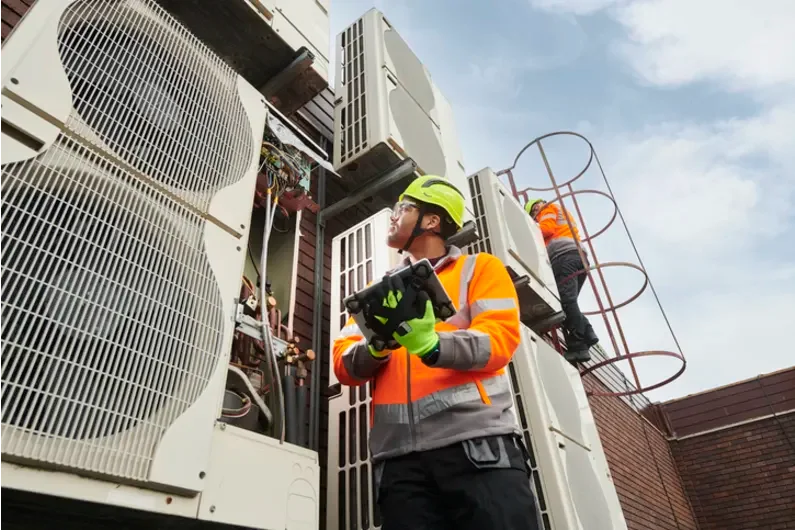VRF Systems HVAC stands for Variable Refrigerant Flow Systems Heating, Ventilation, and Air Conditioning. This type of system is a type of air conditioning system that offers a wide range of benefits, including greater efficiency, precision control, and flexibility. It is also often referred to as a “split system” because the components are split between indoors and outdoors.
In a VRF System HVAC, refrigerant is used to cool the air and move it throughout the building. The system is able to adjust the amount of refrigerant used to adjust the temperature in different parts of the building. This allows for greater control of temperatures throughout, which can save energy. The system also allows for a variety of configurations, such as having multiple outdoor units and indoor units, or having a single outdoor unit with multiple indoor units, allowing for greater flexibility in areas where space is limited.
The system also offers greater energy efficiency than traditional HVAC systems. The refrigerant is recycled, so there is less loss of energy. The system also has the ability to adjust its cooling and heating capacity, which can reduce energy use even further. VRF Systems HVAC is becoming increasingly popular due to its ability to offer greater energy efficiency, precision control, and flexibility. It is a great choice for buildings that require precise control of temperatures, such as office buildings, schools, hospitals, and retail stores.
What are the benefits of using VRF Systems for HVAC, specifically?
VRF systems are more energy efficient than traditional HVAC systems because they permit individual control of the temperature and humidity in each zone of a building. VRF systems are a great option for HVAC systems due to the multiple benefits they offer.
1. Cost Savings: VRF systems require less energy to operate than traditional HVAC systems, resulting in lower energy bills.
2. Flexibility: VRF systems are easily scalable and customizable, allowing you to get the exact performance you need for your space.
3. Efficiency: VRF systems are more efficient than traditional HVAC systems, leading to better air quality and improved comfort.
4. Versatility: VRF systems can be used for both heating and cooling, making them a great option for year-round comfort.
5. Quiet Operation: VRF systems are much quieter than traditional HVAC systems, making them ideal for places where noise is a concern.
6. Long-term Durability: VRF systems are designed to last for many years, meaning you won’t have to worry about costly repairs or replacements.
Overall, VRF systems offer a number of benefits for HVAC systems and can be an excellent option for your home or business.
What are the drawbacks of using VRF Systems as an HVAC system?
VRF systems, or Variable Refrigerant Flow systems, are an increasingly popular HVAC (Heating, Ventilating, and Air Conditioning) system. While they offer many benefits such as energy efficiency and flexibility, these systems also come with some drawbacks.
1. Initial Cost: VRF systems have a higher upfront cost than other HVAC systems due to the complexity of the parts and installation.
2. Installation: VRF systems require specialized knowledge and experience to install correctly. This can make finding a qualified contractor difficult and can lead to longer installation times.
3. Maintenance: VRF systems require more frequent maintenance than other HVAC systems due to the complexity of the parts. This can be costly in the long run.
4. Temperature Control: VRF systems are not as good at controlling temperature as other HVAC systems. This can lead to hot and cold spots in the home or office.
5. Size: VRF systems take up more space than other HVAC systems due to their complexity. This can be a problem for buildings with limited space.
Overall, VRF systems offer many benefits but also come with some drawbacks. It is important to weigh the pros and cons before making a decision on an HVAC system.
What advantages does conventional HVAC lack that VRF systems make up for?
1. Greater Efficiency Because VRF systems are more efficient than conventional HVAC systems, you will have a lower overall energy cost over the course of their lifetime.
2. Increased Levels of Comfort Unlike conventional HVAC systems, variable refrigerant flow (VRF) systems give users better control over the temperature and humidity levels in each individual zone. This results in increased levels of comfort. This indicates that you are able to maintain a comfortable environment even if one region is hotter or colder than another area in the space.
VRF systems are safer for the environment than conventional HVAC systems since they do not employ the usage of hazardous chemicals or refrigerants. This implies that you are able to contribute to the preservation of the natural world while still taking pleasure in the advantages offered by a VRF system.
4. Less Expensive and Time-Consuming Maintenance Because VRF systems require less maintenance than conventional HVAC systems, you can save both time and money on the cost of their upkeep. These systems are also incredibly durable, which means that in comparison to conventional HVAC systems, they will not need to be updated as frequently.
5. A Higher Level of Safety Because VRF systems are so much safer to operate than conventional HVAC systems, you won’t have to be concerned about the potential dangers to your health that are linked to the usage of the latter. Since these systems do not emit any dangerous chemicals or gases into the air, you and your family can relax easy knowing that you are protected from any potential dangers.
What are the many types of VRF Systems that are used in HVAC?
1. air-cooled variable refrigerant flow (VRF) systems Air-cooled variable refrigerant flow (VRF) systems use air to cool the refrigerant, making them more efficient than water-cooled variable refrigerant flow (VRF) systems. However, not only are they more difficult to install, but they also demand a higher level of care.
2. Water-cooled VRF systems Because water is used to cool the refrigerant in water-cooled VRF systems, rather than air, these systems are more efficient than air-cooled VRF systems. However, not only are they more difficult to install, but they also demand a higher level of care.
3. Hybrid variable refrigerant flow systems Because hybrid VRF systems employ both air and water to chill the refrigerant, they are more efficient than both air-cooled and water-cooled variable refrigerant flow (VRF) systems. However, they are more difficult to install and require more upkeep, which drives up the cost.
What is the price range for a VRF Systems HVAC unit?
Installation fees for air-cooled VRF systems typically range from $3,000 to $5,000.
2. Water-cooled VRF systems The installation price for water-cooled VRF systems normally falls somewhere between $5,000 and $7,000.
3. Hybrid VRF systems The installation of a hybrid VRF system normally costs anywhere between $7,000 and $9,000.
How much does it cost to maintain the VRF Systems HVAC system?
1. air-cooled VRF systems: In comparison to water-cooled VRF systems, air-cooled VRF systems require significantly less maintenance. However, they still need to be serviced on a regular basis to ensure that they are functioning in the most effective manner.
2. VRF systems that are cooled by water Instead of air, VRF systems that are cooled by water require additional maintenance. They need to have routine maintenance performed on them more frequently to ensure that they are running well and to prevent leaks.
3. Hybrid variable refrigerant flow (VRF) systems: Hybrid VRF systems call for greater maintenance than either air-cooled or water-cooled VRF systems do. They need to have routine maintenance performed on them more frequently to ensure that they are running well and to prevent leaks.
What is the typical expected lifespan of a VRF Systems HVAC unit?
1. Air-cooled VRF systems: Air-cooled VRF systems have a lifespan that ranges anywhere from 15 to 20 years.
2. Water-cooled VRF systems: The average lifespan for water-cooled VRF systems is between ten and fifteen years.
3. Hybrid VRF systems: The typical lifespan for a hybrid VRF system is between ten and fifteen years.



